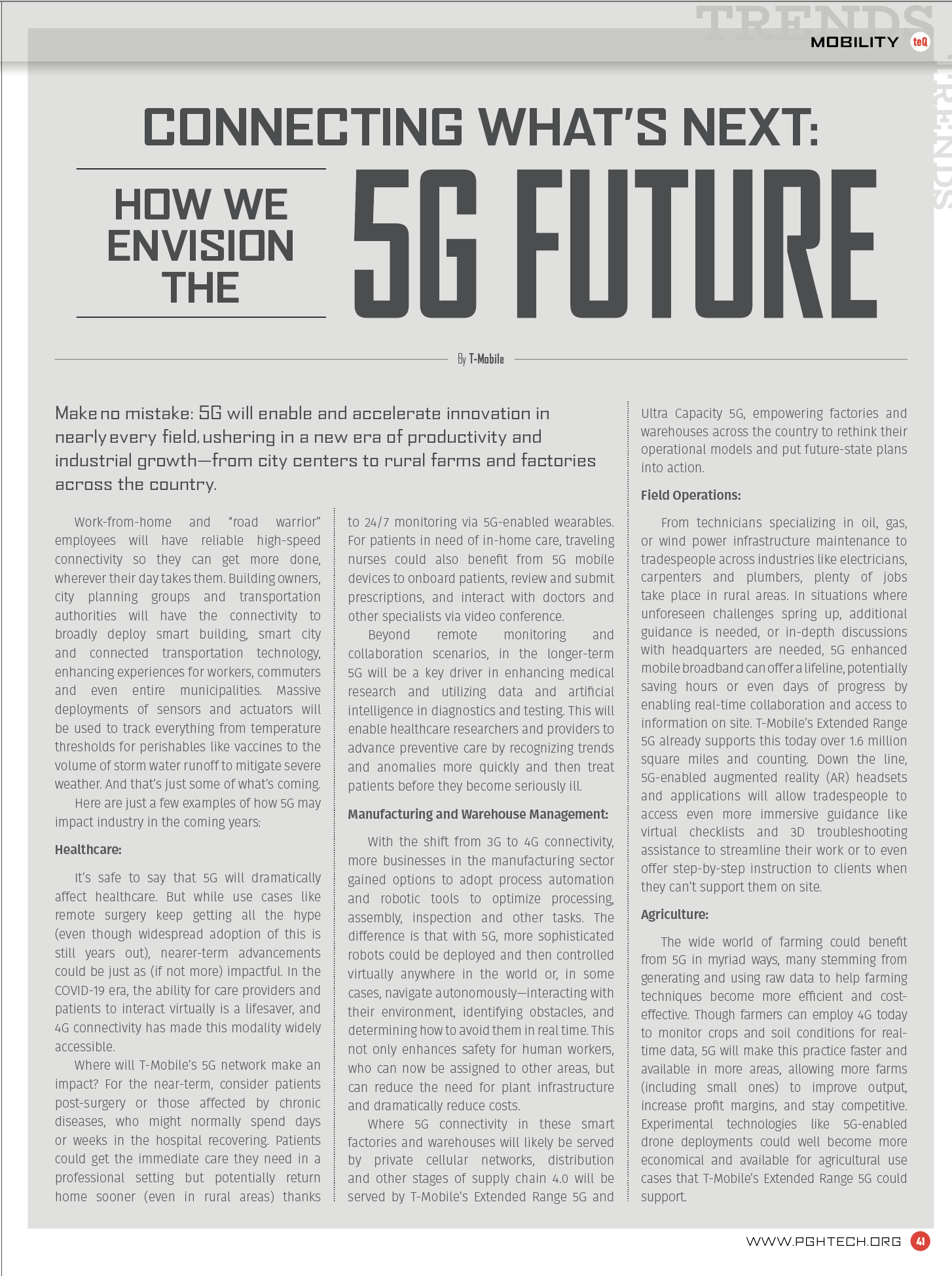Connecting What's Next: The Future of 5G
By T-Mobile
 Make no mistake: 5G will enable and accelerate innovation in nearly every field, ushering in a new era of productivity and industrial growth—from city centers to rural farms and factories across the country.
Make no mistake: 5G will enable and accelerate innovation in nearly every field, ushering in a new era of productivity and industrial growth—from city centers to rural farms and factories across the country.
Work-from-home and “road warrior” employees will have reliable high-speed connectivity so they can get more done, wherever their day takes them. Building owners, city planning groups and transportation authorities will have the connectivity to broadly deploy smart building, smart city and connected transportation technology, enhancing experiences for workers, commuters and even entire municipalities. Massive deployments of sensors and actuators will be used to track everything from temperature thresholds for perishables like vaccines to the volume of storm water runoff to mitigate severe weather. And that’s just some of what’s coming.
Here are just a few examples of how 5G may impact industry in the coming years:
Healthcare:
It’s safe to say that 5G will dramatically affect healthcare. But while use cases like remote surgery keep getting all the hype (even though widespread adoption of this is still years out), nearer-term advancements could be just as (if not more) impactful. In the COVID-19 era, the ability for care providers and patients to interact virtually is a lifesaver, and 4G connectivity has made this modality widely accessible.
Where will T-Mobile’s 5G network make an impact? For the near-term, consider patients post-surgery or those affected by chronic diseases, who might normally spend days or weeks in the hospital recovering. Patients could get the immediate care they need in a professional setting but potentially return home sooner (even in rural areas) thanks to 24/7 monitoring via 5G-enabled wearables. For patients in need of in-home care, traveling nurses could also benefit from 5G mobile devices to onboard patients, review and submit prescriptions, and interact with doctors and other specialists via video conference.
Beyond remote monitoring and collaboration scenarios, in the longer-term 5G will be a key driver in enhancing medical research and utilizing data and artificial intelligence in diagnostics and testing. This will enable healthcare researchers and providers to advance preventive care by recognizing trends and anomalies more quickly and then treat patients before they become seriously ill.
Manufacturing and Warehouse Management:
With the shift from 3G to 4G connectivity, more businesses in the manufacturing sector gained options to adopt process automation and robotic tools to optimize processing, assembly, inspection and other tasks. The difference is that with 5G, more sophisticated robots could be deployed and then controlled virtually anywhere in the world or, in some cases, navigate autonomously—interacting with their environment, identifying obstacles, and determining how to avoid them in real time. This not only enhances safety for human workers, who can now be assigned to other areas, but can reduce the need for plant infrastructure and dramatically reduce costs.
Where 5G connectivity in these smart factories and warehouses will likely be served by private cellular networks, distribution and other stages of supply chain 4.0 will be served by T-Mobile’s Extended Range 5G and Ultra Capacity 5G, empowering factories and warehouses across the country to rethink their operational models and put future-state plans into action.
Field Operations:
From technicians specializing in oil, gas, or wind power infrastructure maintenance to tradespeople across industries like electricians, carpenters and plumbers, plenty of jobs take place in rural areas. In situations where unforeseen challenges spring up, additional guidance is needed, or in-depth discussions with headquarters are needed, 5G enhanced mobile broadband can offer a lifeline, potentially saving hours or even days of progress by enabling real-time collaboration and access to information on site. T-Mobile’s Extended Range 5G already supports this today over 1.6 million square miles and counting. Down the line, 5G-enabled augmented reality (AR) headsets and applications will allow tradespeople to access even more immersive guidance like virtual checklists and 3D troubleshooting assistance to streamline their work or to even offer step-by-step instruction to clients when they can’t support them on site.
Agriculture:
The wide world of farming could benefit from 5G in myriad ways, many stemming from generating and using raw data to help farming techniques become more efficient and cost-effective. Though farmers can employ 4G today to monitor crops and soil conditions for real-time data, 5G will make this practice faster and available in more areas, allowing more farms (including small ones) to improve output, increase profit margins, and stay competitive. Experimental technologies like 5G-enabled drone deployments could well become more economical and available for agricultural use cases that T-Mobile’s Extended Range 5G could support.